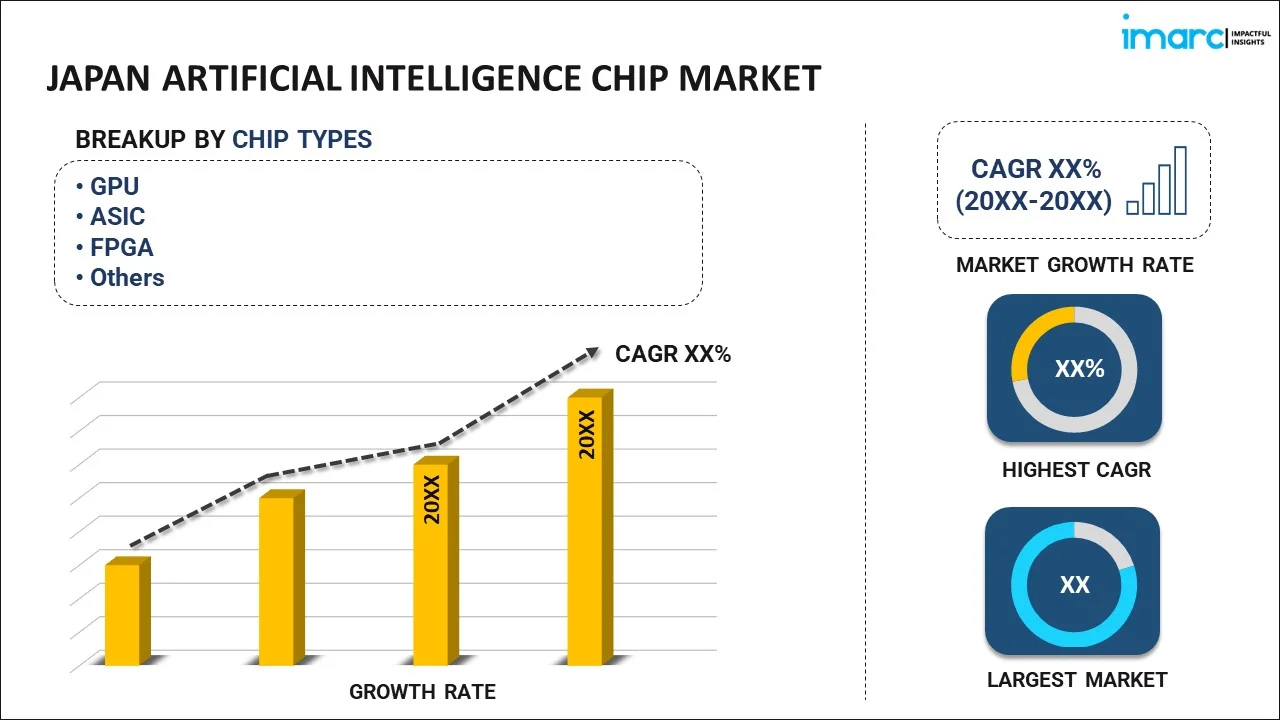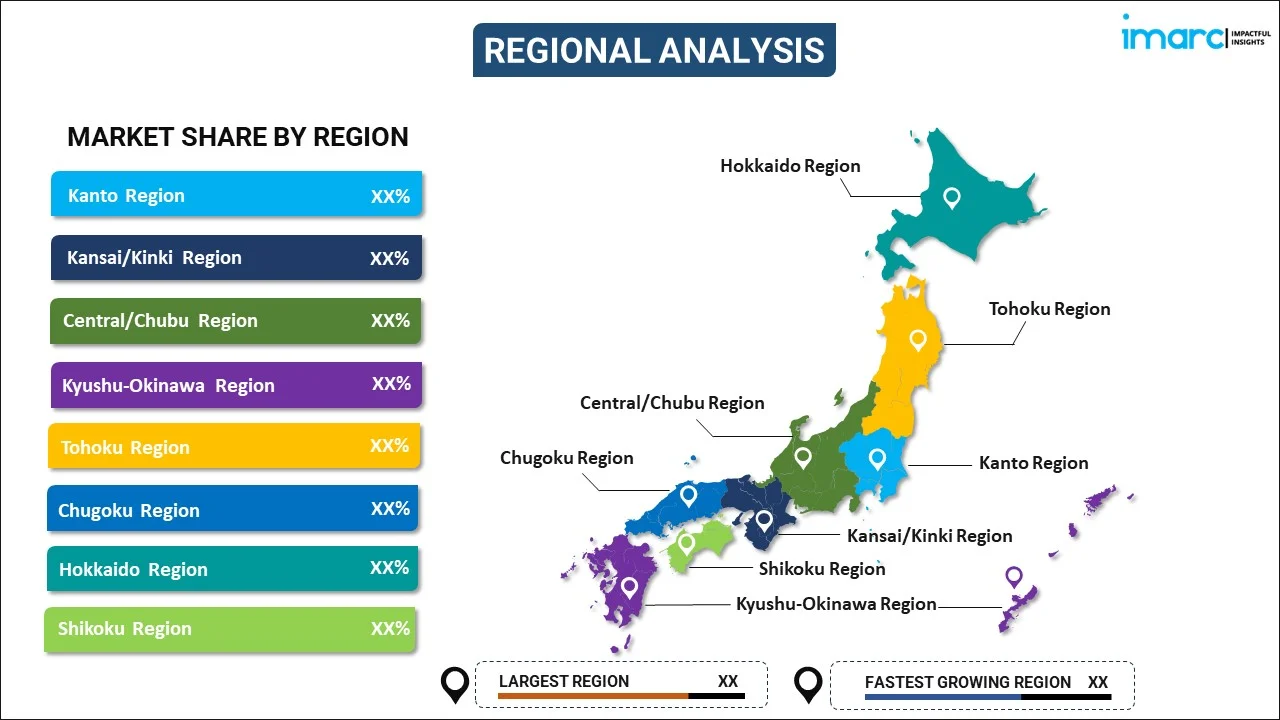
Japan Artificial Intelligence Chip Market Report by Chip Type (GPU, ASIC, FPGA, CPU, and Others), Technology (System-on-Chip (SoC), System-In-Package (SIP), Multi-Chip Module, and Others), Processing Type (Edge, Cloud), Application (Natural Language Processing (NLP), Robotics, Computer Vision, Network Security, and Others), Industry Vertical (Media and Advertising, BFSI, IT and Telecom, Retail, Healthcare, Automotive and Transportation, and Others), and Region 2025-2033
Market Overview:
Japan artificial intelligence chip market size reached USD 864 Million in 2024. Looking forward, IMARC Group expects the market to reach USD 8,777 Million by 2033, exhibiting a growth rate (CAGR) of 29.4% during 2025-2033. The increasing demand for autonomous vehicles and advanced driver-assistance systems (ADAS), which relies heavily on artificial intelligence, is driving the market.
|
Report Attribute
|
Key Statistics
|
|---|---|
|
Base Year
|
2024 |
|
Forecast Years
|
2025-2033 |
|
Historical Years
|
2019-2024
|
| Market Size in 2024 | USD 864 Million |
| Market Forecast in 2033 | USD 8,777 Million |
| Market Growth Rate (2025-2033) | 29.4% |
An artificial intelligence (AI) chip, also known as a neural processing unit (NPU) or AI accelerator, is a specialized microprocessor designed to accelerate AI and machine learning tasks. Unlike traditional central processing units (CPUs) or graphics processing units (GPUs), AI chips are optimized for the specific computational demands of AI algorithms. These chips feature a high degree of parallelism and can perform tasks like deep learning, natural language processing, and computer vision much faster and more efficiently than general-purpose hardware. They often incorporate dedicated hardware for matrix multiplication and neural network inference, which are common operations in AI workloads. AI chips are crucial in enabling the widespread adoption of AI technologies in applications ranging from self-driving cars and healthcare diagnostics to recommendation systems and virtual assistants. Their efficiency and speed make AI more accessible and practical, driving innovation in various industries and paving the way for advancements in AI research and applications.
Japan Artificial Intelligence Chip Market Trends:
The artificial intelligence chip market in Japan is experiencing robust growth due to several key drivers. Firstly, the increasing demand for AI-driven applications across various industries, including healthcare, automotive, and finance, has propelled the need for specialized hardware. Consequently, this has led to a surge in investments in AI chip development. Moreover, the exponential growth of data generated by IoT devices and digital platforms necessitates efficient processing capabilities, and AI chips offer the requisite computational power. Additionally, advancements in machine learning algorithms and deep learning techniques are driving the demand for AI chips, as they require hardware acceleration to perform complex tasks rapidly. Furthermore, AI chips are becoming more energy-efficient, addressing concerns about environmental sustainability and reducing operational costs for businesses. This efficiency is partly attributed to the development of smaller, more compact AI chips with higher processing capacities. In conclusion, the regional AI chip market's growth is driven by the increasing demand for AI-powered applications, the growing volume of data, algorithmic advancements, and energy-efficient hardware solutions. These factors collectively underscore the significance of AI chips in shaping the future of AI technologies.
Japan Artificial Intelligence Chip Market Segmentation:
IMARC Group provides an analysis of the key trends in each segment of the market, along with forecasts at the country level for 2025-2033. Our report has categorized the market based on chip type, technology, processing type, application, and industry vertical.
Chip Type Insights:

- GPU
- ASIC
- FPGA
- CPU
- Others
The report has provided a detailed breakup and analysis of the market based on the chip type. This includes GPU, ASIC, FPGA, CPU, and others.
Technology Insights:
- System-on-Chip (SoC)
- System-In-Package (SIP)
- Multi-Chip Module
- Others
A detailed breakup and analysis of the market based on the technology have also been provided in the report. This includes system-on-chip (SoC), system-in-package (SIP), multi-chip module, and others.
Processing Type Insights:
- Edge
- Cloud
The report has provided a detailed breakup and analysis of the market based on the processing type. This includes edge and cloud.
Application Insights:
- Natural Language Processing (NLP)
- Robotics
- Computer Vision
- Network Security
- Others
A detailed breakup and analysis of the market based on the application have also been provided in the report. This includes natural language processing (NLP), robotics, computer vision, network security, and others.
Industry Vertical Insights:
- Media and Advertising
- BFSI
- IT and Telecom
- Retail
- Healthcare
- Automotive and Transportation
- Others
The report has provided a detailed breakup and analysis of the market based on the industry vertical. This includes media and advertising, BFSI, IT and telecom, retail, healthcare, automotive and transportation, and others.
Regional Insights:

- Kanto Region
- Kansai/Kinki Region
- Central/ Chubu Region
- Kyushu-Okinawa Region
- Tohoku Region
- Chugoku Region
- Hokkaido Region
- Shikoku Region
The report has also provided a comprehensive analysis of all the major regional markets, which include Kanto Region, Kansai/Kinki Region, Central/ Chubu Region, Kyushu-Okinawa Region, Tohoku Region, Chugoku Region, Hokkaido Region, and Shikoku Region.
Competitive Landscape:
The market research report has also provided a comprehensive analysis of the competitive landscape. Competitive analysis such as market structure, key player positioning, top winning strategies, competitive dashboard, and company evaluation quadrant has been covered in the report. Also, detailed profiles of all major companies have been provided.
Japan Artificial Intelligence Chip Market Report Coverage:
| Report Features | Details |
|---|---|
| Base Year of the Analysis | 2024 |
| Historical Period | 2019-2024 |
| Forecast Period | 2025-2033 |
| Units | Million USD |
| Scope of the Report | Exploration of Historical Trends and Market Outlook, Industry Catalysts and Challenges, Segment-Wise Historical and Future Market Assessment:
|
| Chip Types Covered | GPU, ASIC, FPGA, CPU, Others |
| Technologies Covered | System-on-Chip (SoC), System-In-Package (SIP), Multi-Chip Module, Others |
| Processing Types Covered | Edge, Cloud |
| Applications Covered | Natural Language Processing (NLP), Robotics, Computer Vision, Network Security, Others |
| Industry Verticals Covered | Media and Advertising, BFSI, IT and Telecom, Retail, Healthcare, Automotive and Transportation, Others |
| Regions Covered | Kanto Region, Kansai/Kinki Region, Central/ Chubu Region, Kyushu-Okinawa Region, Tohoku Region, Chugoku Region, Hokkaido Region, Shikoku Region |
| Customization Scope | 10% Free Customization |
| Post-Sale Analyst Support | 10-12 Weeks |
| Delivery Format | PDF and Excel through Email (We can also provide the editable version of the report in PPT/Word format on special request) |
Key Questions Answered in This Report:
- How has the Japan artificial intelligence chip market performed so far and how will it perform in the coming years?
- What has been the impact of COVID-19 on the Japan artificial intelligence chip market?
- What is the breakup of the Japan artificial intelligence chip market on the basis of chip type?
- What is the breakup of the Japan artificial intelligence chip market on the basis of technology?
- What is the breakup of the Japan artificial intelligence chip market on the basis of processing type?
- What is the breakup of the Japan artificial intelligence chip market on the basis of application?
- What is the breakup of the Japan artificial intelligence chip market on the basis of industry vertical?
- What are the various stages in the value chain of the Japan artificial intelligence chip market?
- What are the key driving factors and challenges in the Japan artificial intelligence chip?
- What is the structure of the Japan artificial intelligence chip market and who are the key players?
- What is the degree of competition in the Japan artificial intelligence chip market?
Key Benefits for Stakeholders:
- IMARC’s industry report offers a comprehensive quantitative analysis of various market segments, historical and current market trends, market forecasts, and dynamics of the Japan artificial intelligence chip market from 2019-2033.
- The research report provides the latest information on the market drivers, challenges, and opportunities in the Japan artificial intelligence chip market.
- Porter's five forces analysis assist stakeholders in assessing the impact of new entrants, competitive rivalry, supplier power, buyer power, and the threat of substitution. It helps stakeholders to analyze the level of competition within the Japan artificial intelligence chip industry and its attractiveness.
- Competitive landscape allows stakeholders to understand their competitive environment and provides an insight into the current positions of key players in the market.
Need more help?
- Speak to our experienced analysts for insights on the current market scenarios.
- Include additional segments and countries to customize the report as per your requirement.
- Gain an unparalleled competitive advantage in your domain by understanding how to utilize the report and positively impacting your operations and revenue.
- For further assistance, please connect with our analysts.
 Inquire Before Buying
Inquire Before Buying
 Speak to an Analyst
Speak to an Analyst
 Request Brochure
Request Brochure
 Request Customization
Request Customization




.webp)




.webp)












